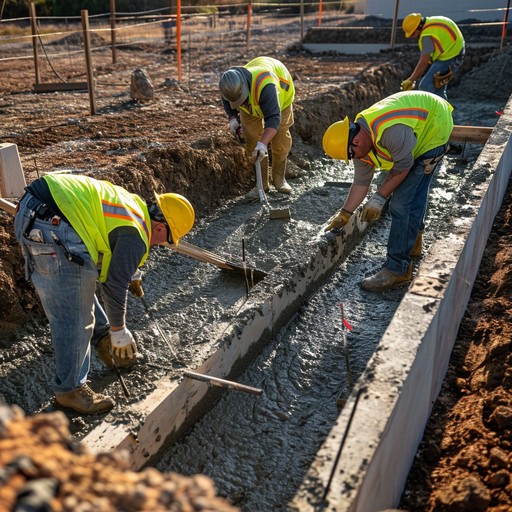If you’re keen on understanding the vital advantages of pre-estimation services in concrete construction, you’ve arrived at the perfect destination. Pre-estimation is a foundational step that paves the way for a seamless and successful construction process. It encompasses a series of crucial activities undertaken before breaking ground, ensuring that your project is not only feasible but also budget-friendly and on schedule.
In this detailed guide, we’ll delve into the significance of pre-estimation, explore the factors influencing precast concrete construction costs, and provide actionable insights on conducting a cost-benefit analysis. Additionally, we’ll discuss how to choose the right estimating company to maximize your project’s success.
Why Pre-Estimation Services Are Crucial for Concrete Construction?
The Role of Pre-Estimation in Ensuring Project Success
Pre-estimation services in concrete construction involve a comprehensive assessment of all project variables before the actual construction begins. This process is vital for several reasons:
- Feasibility Assessment: Pre-estimation helps determine whether the project is viable within the allocated budget and timeline.
- Cost Management: By identifying potential expenses early on, pre-estimation aids in controlling costs and preventing budget overruns.
- Timeline Optimization: Accurate pre-estimation ensures that the project timeline is realistic, helping to avoid delays and costly extensions.
- Risk Mitigation: Pre-estimation identifies potential risks and challenges, allowing stakeholders to address them proactively.
Key Factors Influencing Precast Concrete Construction Costs
The costs associated with precast concrete construction can vary widely based on several factors, including:
- Location: Geographic location impacts labor rates, material availability, and transportation costs, all of which can affect the overall budget.
- Design Complexity: Complex designs often require specialized materials and labor, leading to higher costs.
- Project Size: Larger projects may benefit from economies of scale, but they also require more resources and planning.
- Material Availability: Fluctuations in material availability and prices can significantly impact project costs.
While initial estimations for precast concrete may appear high due to manufacturing, transportation, and handling costs, a thorough pre-estimation process can help identify areas where costs can be optimized, making the project more cost-effective in the long run.
Conducting a Cost-Benefit Analysis for Precast Concrete Construction
A cost-benefit analysis (CBA) is an essential tool for evaluating the financial viability of a precast concrete construction project. It helps determine whether the potential benefits of the project outweigh the associated costs.
Step 1: Identifying All Costs
The first step in conducting a CBA is to identify all relevant costs associated with the project. These include:
- Direct Costs: Expenses directly tied to the construction process, such as materials, labor, equipment rental, and transportation.
- Indirect Costs: Costs that are not directly related to construction but are still essential, such as permits, insurance, and administrative expenses.
- Contingency Costs: Budget allowances for unforeseen expenses that may arise during the project, such as delays or cost overruns.
Accurate cost identification is crucial for a successful CBA, as it ensures that all financial outlays are accounted for.
Step 2: Identifying All Benefits
Once the costs are identified, the next step is to outline all the benefits associated with the project. In precast concrete construction, benefits can include:
- Cost Savings: Precast concrete can lead to long-term cost savings due to its durability and reduced need for maintenance.
- Time Efficiency: Projects using precast concrete components often have shorter construction times, leading to quicker project completion.
- Quality Assurance: Precast elements are manufactured in controlled environments, ensuring consistent quality and reducing the risk of on-site errors.
- Sustainability: Precast concrete supports sustainability goals by reducing construction waste and enabling the use of recycled materials.
Step 3: Assigning Monetary Values to Costs and Benefits
To effectively compare costs and benefits, it’s essential to assign monetary values to each. This involves:
- Estimating Costs: Use current market rates to calculate the total cost of materials, labor, and other expenses.
- Valuing Benefits: Assign a dollar value to each identified benefit, such as the savings from reduced construction time or lower maintenance costs over the project’s lifespan.
Step 4: Comparing Costs and Benefits
With monetary values assigned, the next step is to compare the total costs with the total benefits. This comparison will help determine the project’s net benefit, which is calculated by subtracting the total costs from the total benefits. If the net benefit is positive, the project is likely to be financially viable.
Step 5: Adjusting for Uncertainty and Risks
No construction project is without risks. Therefore, it’s crucial to adjust the CBA for uncertainty by considering potential risks such as:
- Project Delays: Delays can lead to increased costs, particularly in labor and equipment rental.
- Cost Increases: Material costs may rise due to inflation or supply chain disruptions, impacting the overall budget.
- Unforeseen Events: Natural disasters, regulatory changes, or other unforeseen events can significantly impact the project’s financials.
Conducting a sensitivity analysis allows stakeholders to understand how changes in key variables might affect the project’s overall viability, enabling them to make more informed decisions.
Case Study: The Impact of Pre-Estimation on Complex Construction Projects
Let’s explore a real-world example to highlight the importance of pre-estimation services in complex construction projects.
The HVAC System Upgrade Scenario
Imagine a scenario where a building’s HVAC system needs to be upgraded to accommodate additional equipment. Without pre-estimation, the project could face significant challenges, including system overload, increased costs, and delays.
By involving an HVAC engineer early in the project, the current system’s capacity can be assessed, and accurate cost estimates for the upgrade can be provided. This collaborative approach ensures that all stakeholders have a clear understanding of the project’s scope and cost implications, leading to a smoother, more cost-effective execution.
This case study underscores the importance of involving experts in the pre-estimation process to ensure project stability and avoid costly mistakes.
How to Choose the Right Estimating Company for Your Project
Selecting the right estimating company is critical to the success of your construction project. Here are five key factors to consider:
1. Industry Experience
Opt for a company with extensive experience in your specific industry. A company with a proven track record in similar projects is more likely to provide accurate and reliable estimates.
2. Reputation and References
Research the company’s reputation by reading reviews, testimonials, and case studies. Speaking with previous clients can provide valuable insights into the company’s reliability and quality of work.
3. Qualified and Skilled Estimators
Ensure that the company employs qualified and experienced estimators who understand the intricacies of your project, whether it’s residential, commercial, or industrial.
4. Use of Advanced Technology
Advanced estimating software is essential for producing detailed and accurate estimates. The use of technology reduces the likelihood of errors and ensures that all aspects of the project are considered.
5. Customization and Flexibility
The ability to adapt to changes is crucial in construction. Choose a company that offers customizable services and can adjust estimates as the project evolves. Flexibility ensures that your project remains on track, even when unexpected changes arise.
Financial and Strategic Benefits of Pre-Estimation
By investing in pre-estimation services, you gain:
- Enhanced Cost Control: Pre-estimation helps in identifying potential expenses early, allowing for better budget management and cost savings.
- Improved Time Management: Accurate pre-estimation ensures that the project timeline is realistic, helping to avoid costly delays.
- Effective Risk Management: Identifying potential risks and challenges during the pre-estimation phase allows for proactive mitigation strategies.
- Better Stakeholder Communication: Detailed estimates facilitate clear communication among stakeholders, ensuring that everyone is aligned with the project’s goals.
Final Thoughts:
Pre-estimation services are not just a preliminary step; they are the foundation upon which successful concrete construction projects are built. By thoroughly assessing the project’s feasibility, costs, and potential benefits, stakeholders can make informed decisions that lead to successful project completion.
When the benefits outweigh the costs, and potential risks are effectively managed, a construction project is well on its way to success. Pre-estimation services in concrete construction provide the clarity, foresight, and strategic planning necessary to navigate the complexities of modern construction projects.

